Precipitation Evolution in the Austenitic Heat-Resistant Steel HR3C upon Creep at 700 °C and 750 °C
Abstract
:1. Introduction
2. Materials and Methods
3. Results and Discussion
3.1. Creep Rupture Test
3.1.1. Fracture Morphology
3.1.2. Precipitation Behavior
4. Conclusions
- The dense Z-phase, including primary coarse Z-phase (~1 μm) and secondary fine Z-phase (~50 nm), dispersively precipitated in the matrix along the dislocation lines. Moreover, it showed high stability (both the size and the area fraction of ~0.8%) against coarsening with the extension of creep time;
- The M23C6 preferentially precipitated at the grain boundaries and coarsened distinctly from ~200 nm to ~600 nm after a creep rupture of 9411 h. Meanwhile, granular M23C6 continuously precipitated in the matrix with the extension of creep rupture time and kept a relatively stable size of ~200–300 nm under long-term creep exposure;
- The σ phase did not observe in the early stage of creep exposure till 700 °C/120 MPa/3945 h and 750 °C/120 MPa/2310 h. The fraction of the σ phase grew linearly with increasing time to rupture and the growth rate of σ phase at 750 °C was higher than at 700 °C;
- All the crept HR3C specimens showed the intergranular brittle fracture under different stresses. As the time to creep rupture increased (low creep stress), partial dimple morphology formed on fracture facets by the void nucleation of M23C6. Coarse M23C6 and σ phase at the grain boundaries served as nucleation sites for high stress concentrations and creep cavities and led to the propagation of cracks on the grain boundaries and an eventual intergranular fracture;
- Creep rupture mechanism and corrosion: the creep rupture specimens showed a typical intergranular fracture with small dimples caused by the decoupling of M23C6, indicating that the grain boundary was weakened due to the dense precipitation of this phase, even though the matrix was ductile enough to show dimples. The coarse and brittle σ phases do not play any significant role in strengthening. The depletion of Cr in the periphery of the grain boundary is expected to be a cause of corrosion.
Author Contributions
Funding
Institutional Review Board Statement
Informed Consent Statement
Data Availability Statement
Conflicts of Interest
References
- Hu, Z.F. Heat-resistant steels, microstructure evolution and life assessment in power plants. Therm. Power Plants 2012, 10, 195–226. [Google Scholar]
- Wang, J.Z.; Liu, Z.D.; Bao, H.S.; Cheng, S.C.; Bin, W. Effect of aging at 700 °C on microstructure and mechanical properties of S31042 heat resistant steel. J. Iron Steel Res. 2013, 20, 54–58. [Google Scholar] [CrossRef]
- Zhou, Y.; Liu, Y.; Zhou, X.; Liu, C.; Yu, J.; Huang, Y.; Li, H.; Li, W. Precipitation and hot deformation behavior of austenitic heat-resistant steels: A review. J. Mater. Sci. Technol. 2017, 33, 1448–1456. [Google Scholar] [CrossRef]
- Iseda, A.; Okada, H.; Semba, H.A.; Igarashi, M. Long term creep properties and microstructure of SUPER304H, TP347HFG, and HR3C for A-USC boilers. Energy Mater. 2007, 2, 199–206. [Google Scholar] [CrossRef]
- Gharehbaghi, A. Precipitation Study in a High Temperature Austenitic Stainless Steel Using Low Voltage Energy dispersive X-ray Spectroscopy. Master’s Thesis, Royal Institute of Technology (KTH), Stockholm, Sweden, 2012. [Google Scholar]
- Jack, D.H.; Jack, K.H. Crystal Structure of Nb Cr N. J. Iron Steel Inst. 1972, 209, 790–792. [Google Scholar]
- Golański, G.; Zieliński, A.; Sroka, M.; Słania, J. The effect of service on microstructure and mechanical properties of HR3C heat-resistant austenitic stainless steel. Materials 2020, 13, 1297. [Google Scholar] [CrossRef] [PubMed] [Green Version]
- Bin, W.; Liu, Z.C.; Cheng, S.C.; Liu, C.M.; Wang, J.Z. Microstructure evolution and mechanical properties of HR3C steel during long-term aging at high temperature. J. Iron Steel Res. 2014, 21, 765–773. [Google Scholar]
- Hong, H.U.; Nam, S.W. The occurrence of grain boundary serration and its effect on the M23C6 carbide characteristics in an AISI 316 stainless steel. Mater. Sci. Eng. A 2002, 332, 255–261. [Google Scholar] [CrossRef]
- Zhang, Z.; Hu, Z.; Tu, H.; Schmauder, S.; Wu, G. Microstructure evolution in HR3C austenitic steel during long-term creep at 650 °C. Mater. Sci. Eng. A 2017, 681, 74–84. [Google Scholar] [CrossRef]
- Lee, J.; Kim, I.; Kimura, A. Application of small punch test to evaluate sigma-phase embrittlement of pressure vessel cladding material. J. Nucl. Sci. Technol. 2003, 40, 664–671. [Google Scholar] [CrossRef]
- Ji, Y.S.; Park, J.; Lee, S.Y.; Kim, J.W.; Lee, S.M.; Nam, J.; Shim, J.H. Long-term evolution of σ phase in 304H austenitic stainless steel: Experimental and computational investigation. Mater. Charact. 2017, 128, 23–29. [Google Scholar] [CrossRef]
- Schwind, M.; Källqvist, J.; Nilsson, J.O.; Ågren, J.; Andrén, H.O. σ-phase precipitation in stabilized austenitic stainless steels. Acta Mater. 2000, 48, 2473–2481. [Google Scholar] [CrossRef]
- Cao, T.S.; Cheng, C.Q.; Zhao, J.; Wang, H. Precipitation behavior of σ phase in ultra-supercritical boiler applied HR3C heat-resistant steel. Acta Metall. Sin. 2019, 32, 1355–1361. [Google Scholar] [CrossRef] [Green Version]
- Sawada, K.; Kimura, K.; Abe, F. Data Sheets on the Elevated-Temperature Properties of 25Cr–20Ni–Nb–N Stainless Steel Tube for Power Boilers (KA-SUS310J1 TB). NIMS Creep Data Sheet No. 58: National Institute for Materials Science. 2011. Available online: https://mdr.nims.go.jp/concern/publications/v118rf25g (accessed on 28 June 2022).
- Wang, R.; Duan, M.; Zhang, J.; Chen, G.; Miao, C.; Chen, X.; Li, J.; Tang, W. Microstructure Characteristics and Their Effects on the Mechanical Properties of As-Served HR3C Heat-Resistant Steel. J. Mater. Eng. Perform. 2021, 30, 4552–4561. [Google Scholar] [CrossRef]
- Zieliński, A.; Sroka, M.; Hernas, A.; Kremzer, M. The effect of long-term impact of elevated temperature on changes in microstructure and mechanical properties of HR3C steel. Arch. Metall. Mater. 2016, 61, 761–765. [Google Scholar] [CrossRef] [Green Version]
- Hu, Z.F.; Zhang, Z. Investigation the effect of precipitating characteristics on the creep behavior of HR3C austenitic steel at 650 °C. Mater. Sci. Eng. A 2019, 742, 451–463. [Google Scholar] [CrossRef]
- Hong, H.U.; Rho, B.S.; Nam, S.W. Correlation of the M23C6 Precipitation Morphology with Grain Boundary Characteristics in Austenitic Stainless Steel. Mater. Sci. Eng. A 2001, 318, 285–292. [Google Scholar] [CrossRef]
- Alsmadi, Z.Y.; Abouelella, H.; Alomari, A.S.; Murty, K.L. Stress-Controlled Creep–Fatigue of an Advanced Austenitic Stainless Steel at Elevated Temperatures. Materials 2022, 15, 3984. [Google Scholar] [CrossRef]
- Zieliński, A.; Golański, G.; Sroka, M. Evolution of the microstructure and mechanical properties of HR3C austenitic stainless steel after ageing for up to 30,000 h at 650–750 °C. Mater. Sci. Eng. A 2020, 796, 139944. [Google Scholar] [CrossRef]
- Vujic, S.; Standströ, R.; Sommitsch, C. Precipitation evolution and creep strength modeling of 25Cr20NiNbN austenitic steel. Mater. High Temp. 2015, 32, 607–618. [Google Scholar] [CrossRef]
- Terada, M.; Escriba, D.M.; Costa, I.; Materna-Morris, E.; Padliha, A.F. Investigation on the intergranular corrosion resistance of the AISI 316L(N) stainless steel after long time creep testing. Mater. Charact. 2008, 59, 663–668. [Google Scholar] [CrossRef]
- Kaneko, K.; Futunaga, T.; Yamada, K.; Nakada, N.; Kikuchi, M.; Saghi, Z.; Barnad, J.S.; Midgley, P.A. Formation of M23C6—Type precipitates and chromium–depleted zone in austenite stainless steel. Scr. Mater. 2011, 65, 509–512. [Google Scholar] [CrossRef]
- Yan, J.; Gu, Y.; Sun, F.; Xu, Y.; Yuan, Y.; Lu, Y.; Yang, Z.; Dang, Y. Evolution of microstructure and mechanical properties of a 25Cr-20Ni heat resistant alloy after long-term. Mater. Sci. Eng. A 2016, 675, 289–298. [Google Scholar] [CrossRef]

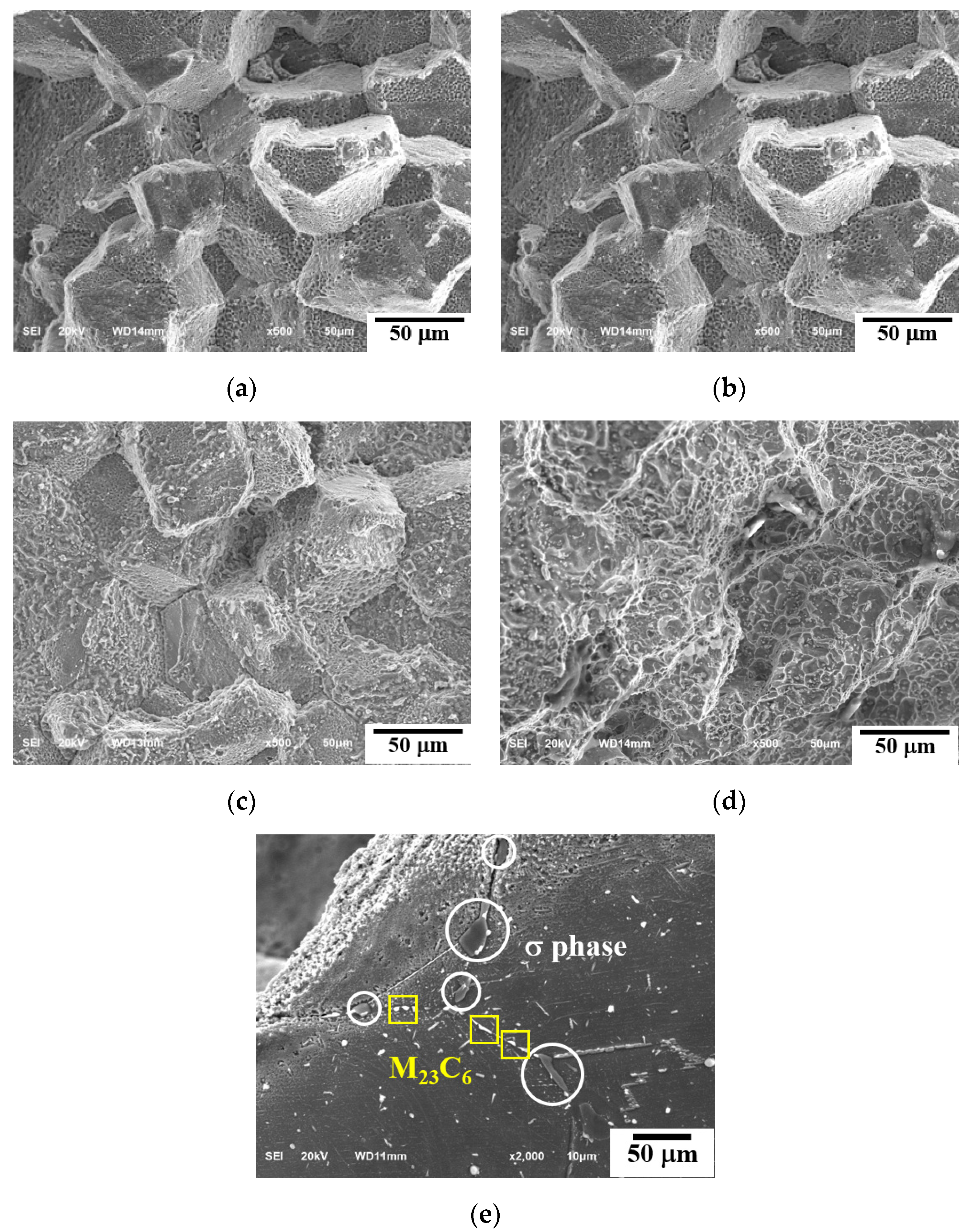
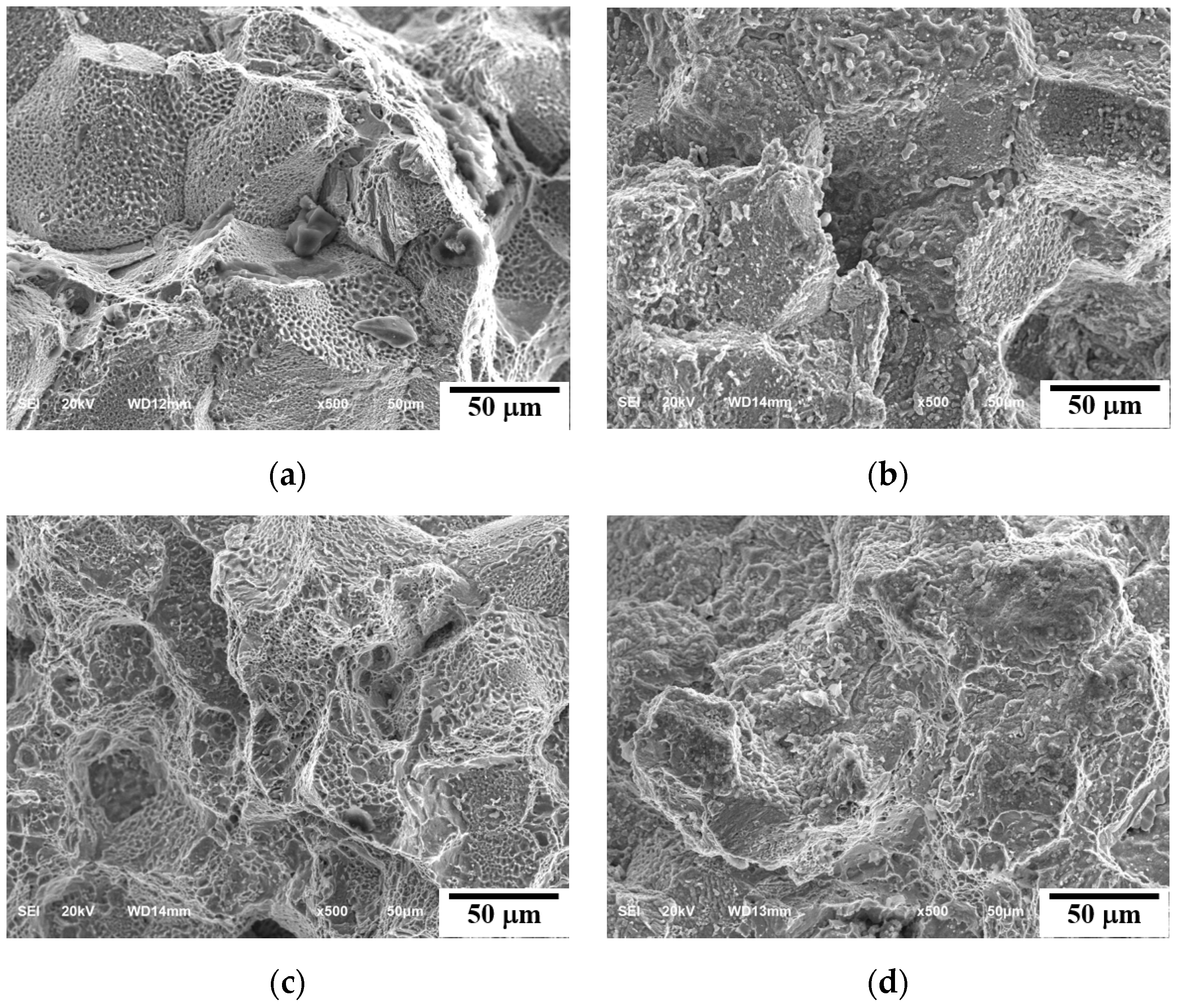

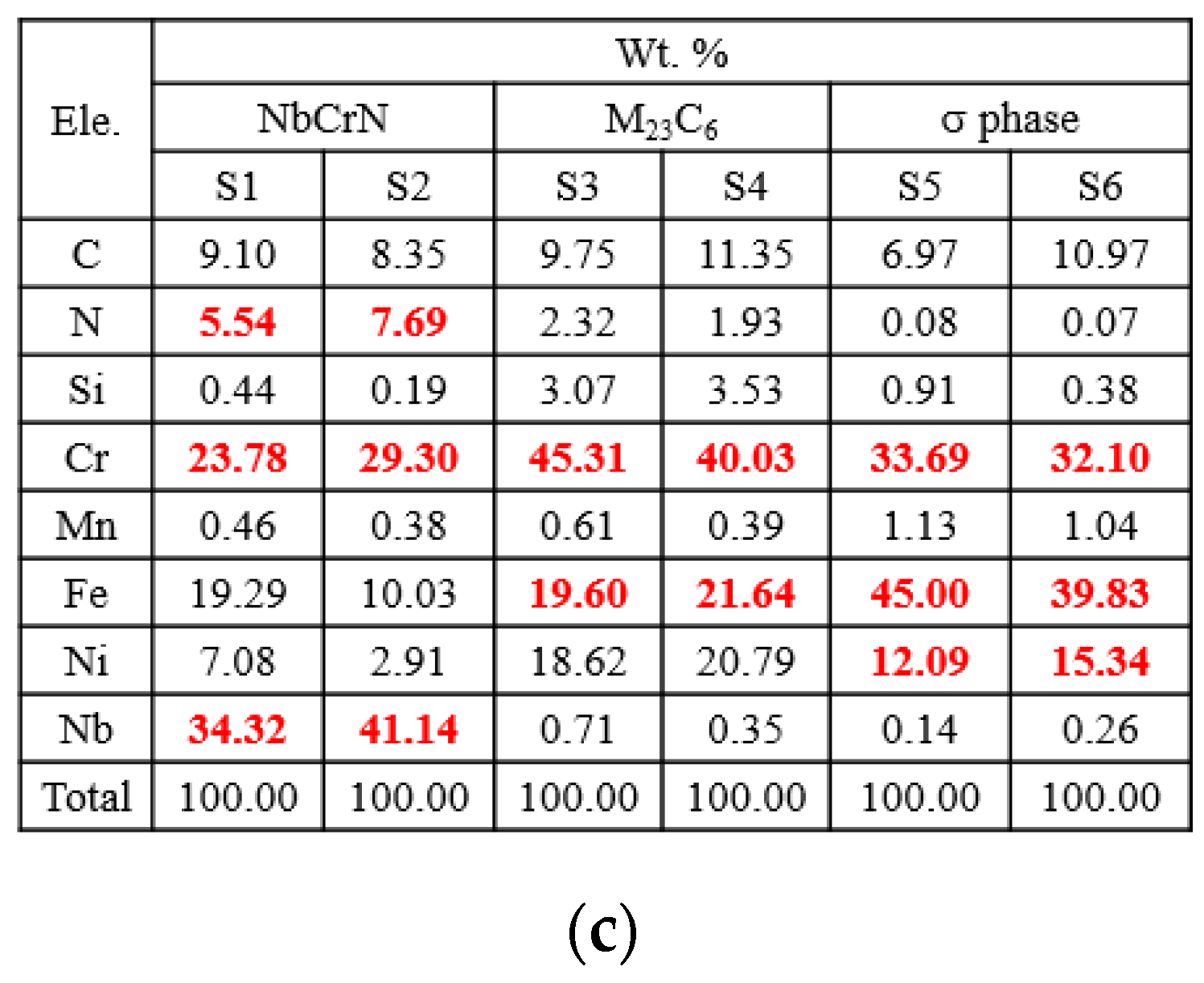

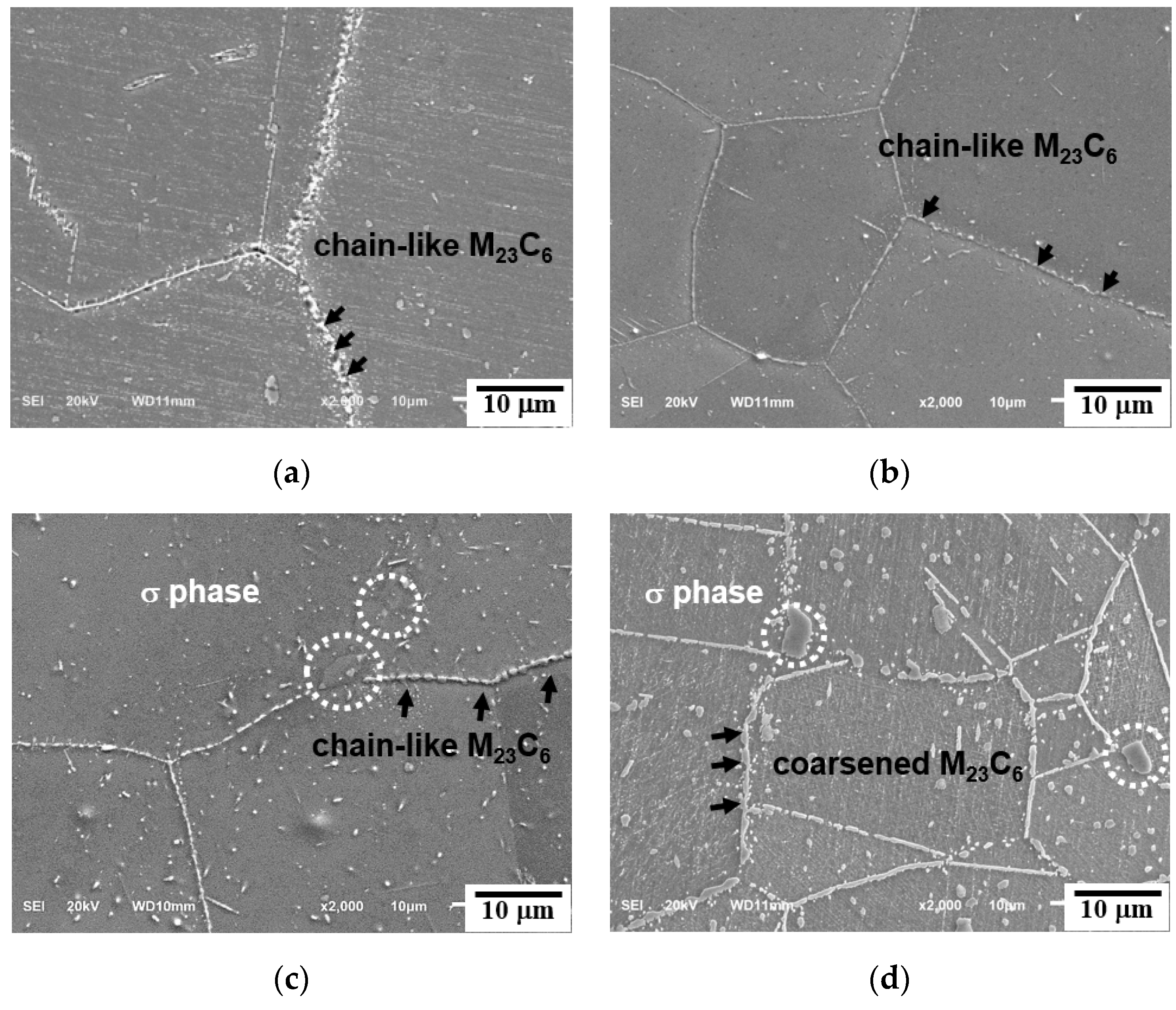
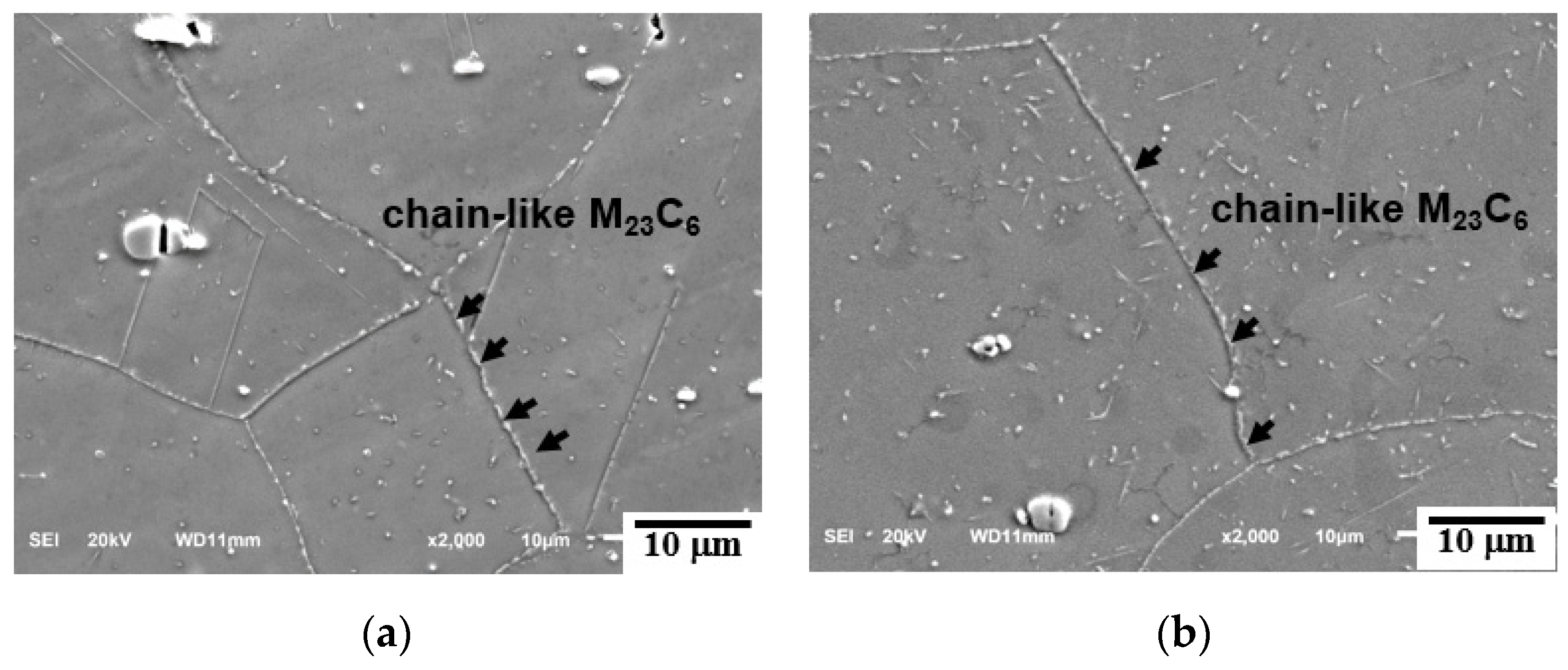
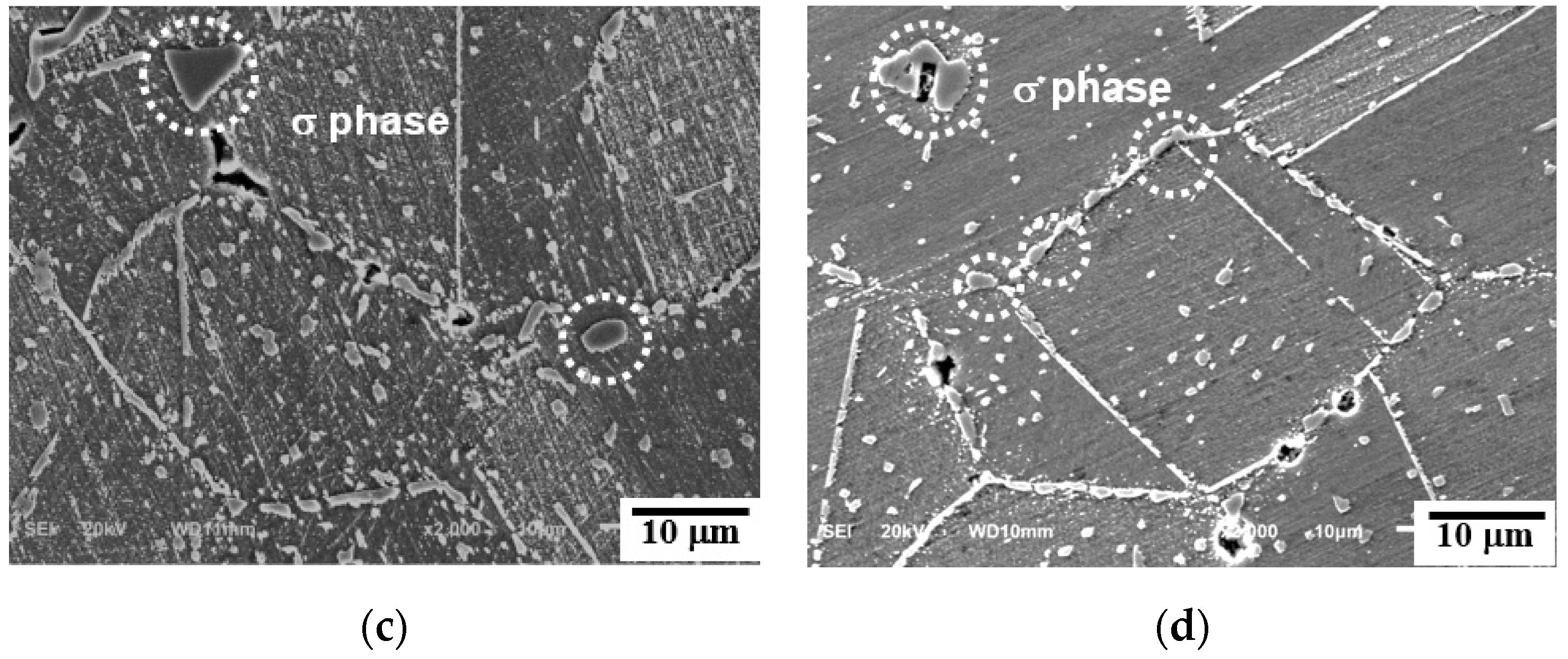

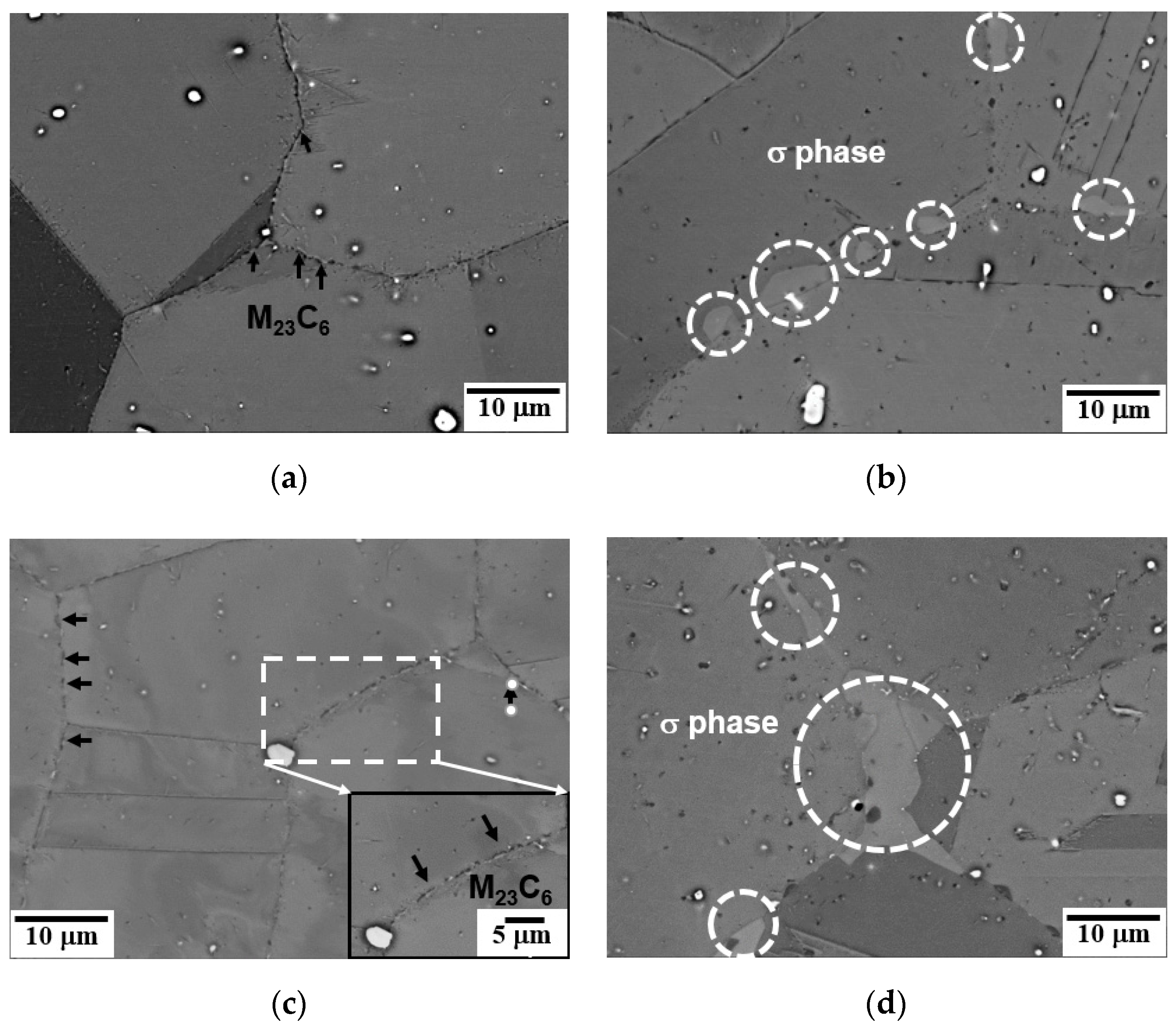
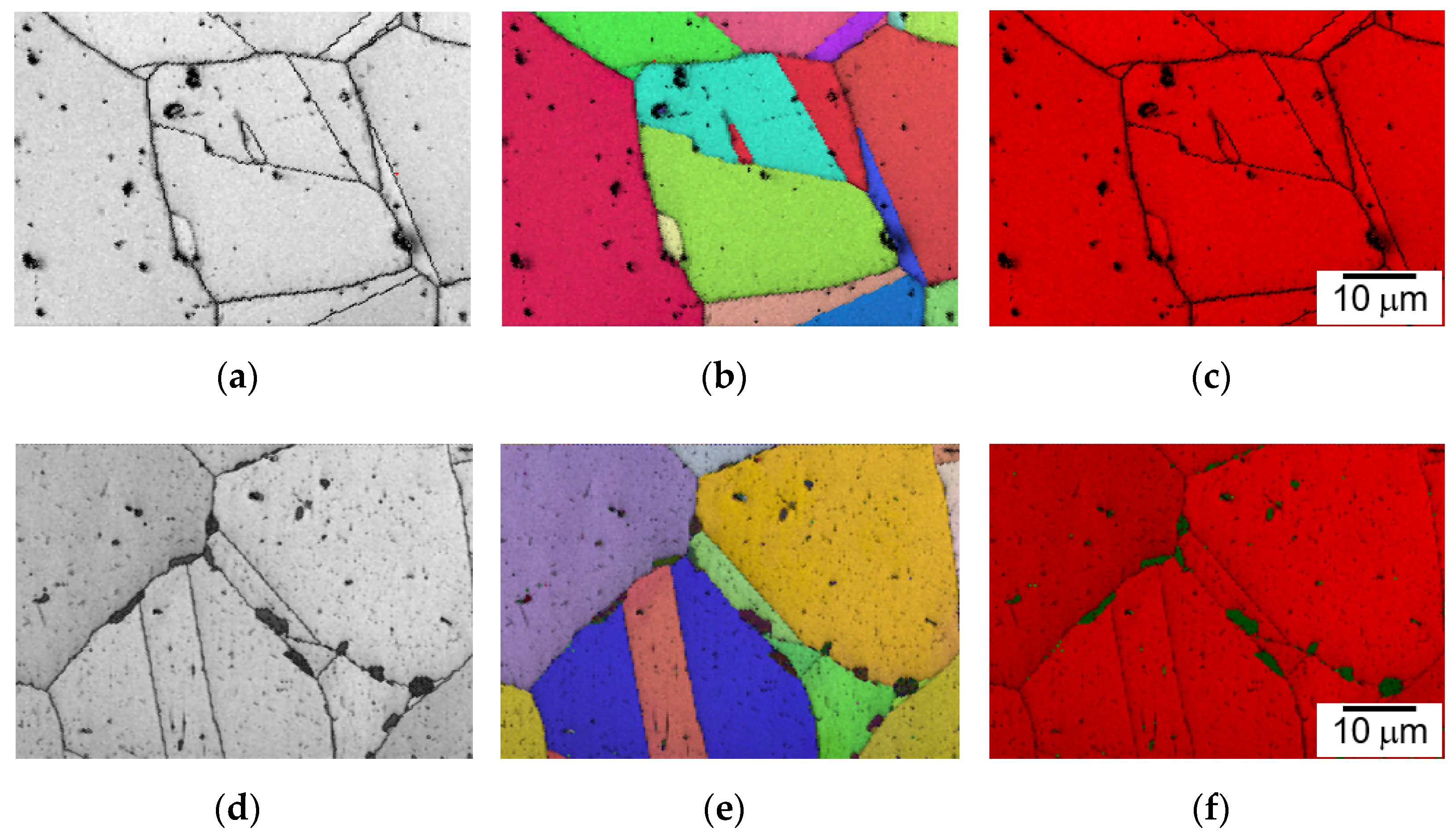

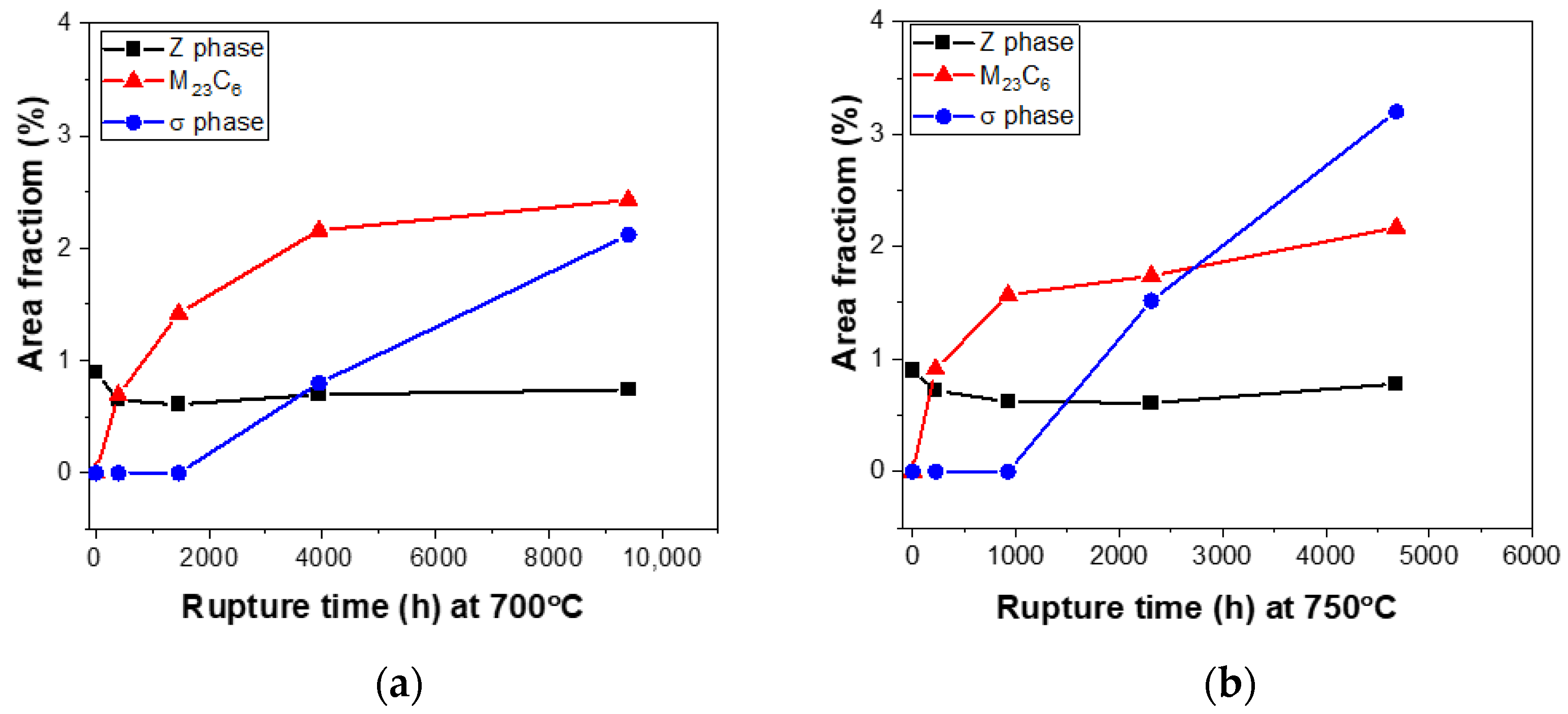
| Element | Cr | Ni | Nb | C | N | Mn | Si | Fe |
|---|---|---|---|---|---|---|---|---|
| ASTM A213 | 24.0~ 26.0 | 19.0~ 22.0 | 0.20~ 0.60 | 0.04~ 0.10 | 0.15~ 0.35 | 2.00 max | 1.50 max | Balance |
| * EDS result | 24.4 | 18.4 | 0.4 | 5.9 | 0.3 | 1.2 | 0.4 | 49.0 |
| State | Stress (MPa) | Time (h) |
|---|---|---|
| As-received | - | - |
| 700 °C | 180 | 398 |
| 150 | 1463 | |
| 120 | 3945 | |
| 90 | 9411 | |
| 750 °C | 140 | 222 |
| 110 | 925 | |
| 90 | 2310 | |
| 70 | 4680 |
Publisher’s Note: MDPI stays neutral with regard to jurisdictional claims in published maps and institutional affiliations. |
© 2022 by the authors. Licensee MDPI, Basel, Switzerland. This article is an open access article distributed under the terms and conditions of the Creative Commons Attribution (CC BY) license (https://creativecommons.org/licenses/by/4.0/).
Share and Cite
Xu, L.; He, Y.; Kang, Y.; Jung, J.-s.; Shin, K. Precipitation Evolution in the Austenitic Heat-Resistant Steel HR3C upon Creep at 700 °C and 750 °C. Materials 2022, 15, 4704. https://doi.org/10.3390/ma15134704
Xu L, He Y, Kang Y, Jung J-s, Shin K. Precipitation Evolution in the Austenitic Heat-Resistant Steel HR3C upon Creep at 700 °C and 750 °C. Materials. 2022; 15(13):4704. https://doi.org/10.3390/ma15134704
Chicago/Turabian StyleXu, Liming, Yinsheng He, Yeonkwan Kang, Jine-sung Jung, and Keesam Shin. 2022. "Precipitation Evolution in the Austenitic Heat-Resistant Steel HR3C upon Creep at 700 °C and 750 °C" Materials 15, no. 13: 4704. https://doi.org/10.3390/ma15134704






